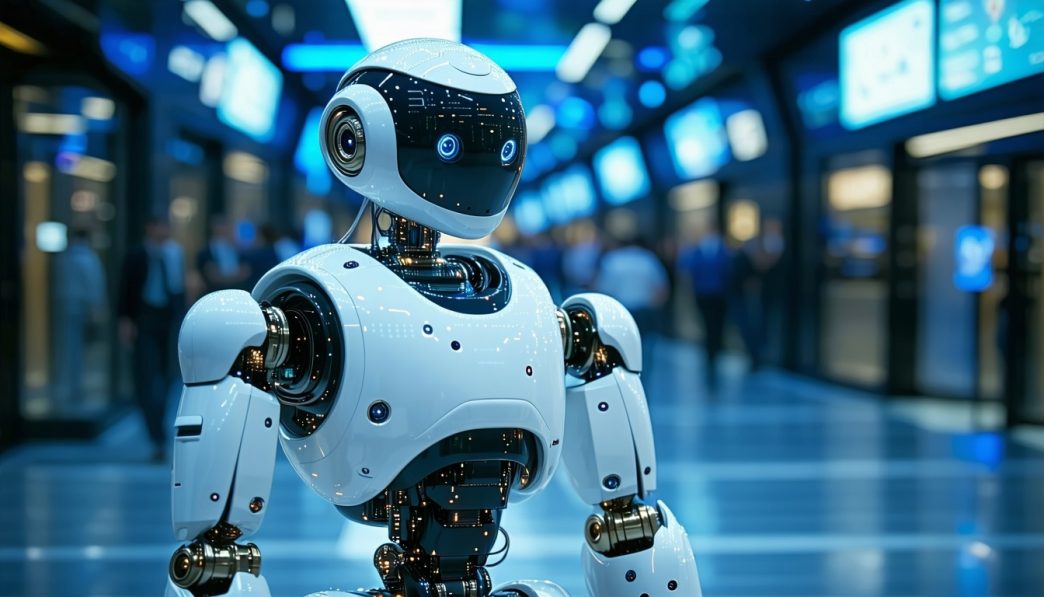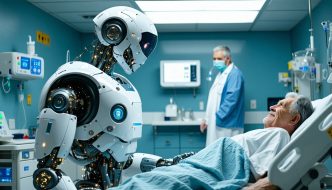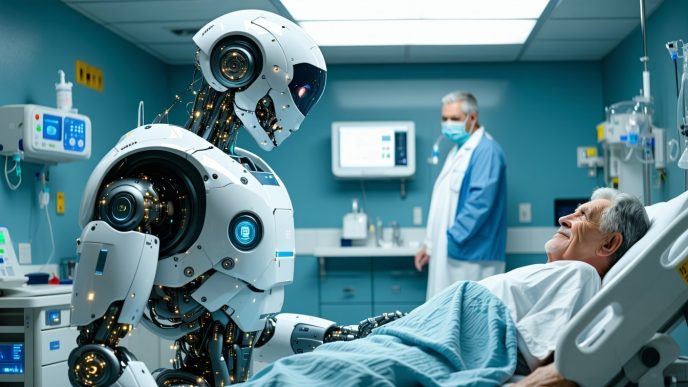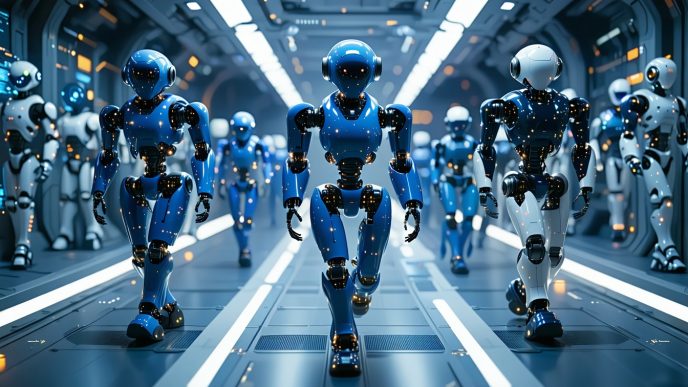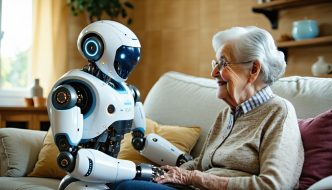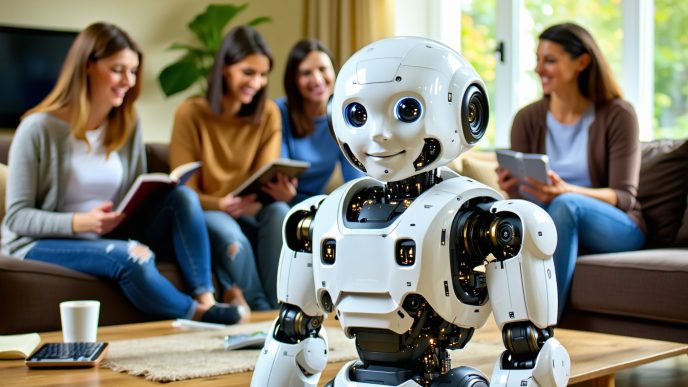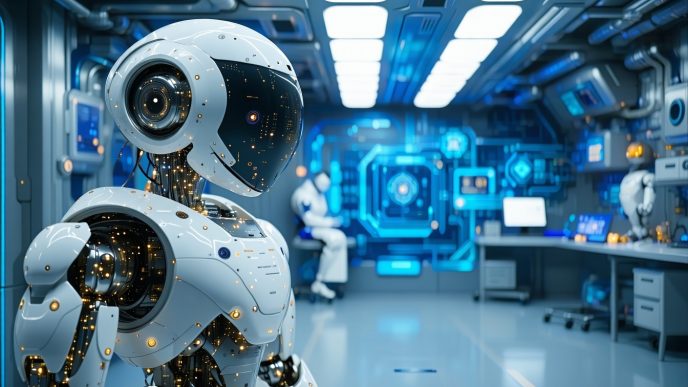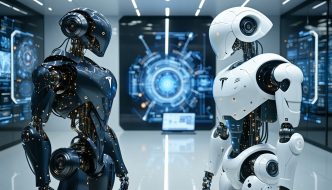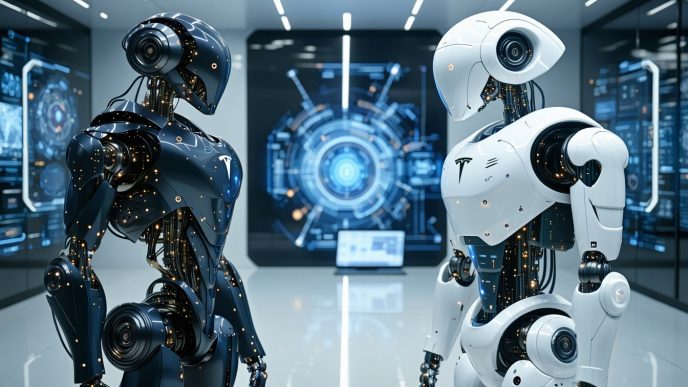Introduction to Humanoid Robots
What are Humanoid Robots?
Humanoid robots are mechanical entities designed to resemble the human form and exhibit human-like characteristics. These robots often have a head, torso, arms, and legs, allowing them to perform tasks that require a blend of physical capabilities and social interactions. The development of humanoid robots involves advanced technologies that enable them to walk, talk, and even respond emotionally to human stimuli. This unique design makes them suitable for various applications, particularly in domains where interaction with humans is essential.
Applications of Humanoid Robots
Humanoid robots have a wide range of applications across various sectors. Here are some notable uses:
| Application Area | Description |
|---|---|
| Home Assistance | Designed to help with daily tasks, humanoid robots can assist in household chores and provide companionship. They are often integrated into smart homes for enhanced functionality, as showcased in humanoid robots for home use. |
| Education | These robots serve as teaching assistants, providing interactive learning experiences for students. They are capable of engaging students with personalized content and support for various subjects, including STEM (Science, Technology, Engineering, and Mathematics). |
| Healthcare | In the medical field, humanoid robots can assist with patient care and rehabilitation. They can also help remind patients to take medications, exemplifying their role in humanoid robots in healthcare. |
| Security | Robotic models equipped with monitoring capabilities can enhance home security systems. They perform surveillance tasks and can alert homeowners about potential threats, thus making them a pivotal part of humanoid robots for security. |
| Customer Service | Many businesses employ humanoid robots in service roles, where they welcome customers, provide information, and assist with inquiries. This use case enhances user experience and operational efficiency. |
By integrating humanoid robots into these areas, organizations can leverage their unique features to improve efficiency, enhance monitoring, and foster human-robot interactions.
Role of Humanoid Robots in Home Surveillance
Humanoid robots are increasingly being utilized for home surveillance, adding a unique dimension to security systems. Their design and capabilities offer both advantages and challenges in protecting homes.
Advantages of Using Humanoid Robots
The integration of humanoid robots in home security comes with several benefits:
-
Mobile Surveillance: Unlike traditional security cameras, humanoid robots can move around the home, providing real-time monitoring in multiple locations. This mobility allows them to cover more ground effectively.
-
Interactive Capabilities: Humanoid robots can engage with individuals in the home, providing alerts or communication during potential security breaches. This interaction can be helpful in managing unexpected situations.
-
Data Collection: Equipped with advanced sensors and cameras, these robots can gather data on unusual activities or detect intruders. This data can be analyzed for improved security measures.
-
Deter Intruders: The presence of a humanoid robot can deter potential intruders. A robot that moves, interacts, and monitors can create a sense of uncertainty for individuals intending to commit theft or other crimes.
-
Integration with Smart Home Systems: Humanoid robots can seamlessly integrate with existing smart home technologies, enhancing the effectiveness of overall home security. They can communicate with other devices to respond to threats promptly.
The table below highlights the advantages of humanoid robots for security:
| Advantages | Description |
|---|---|
| Mobile Surveillance | Covers multiple areas in real-time. |
| Interactive Capabilities | Engages users for alerts and communication. |
| Data Collection | Gathers information on unusual activities. |
| Deter Intruders | Creates uncertainty for potential criminals. |
| Integration with Smart Systems | Works alongside residential automation technologies. |
Challenges and Limitations
Despite the advantages, there are challenges associated with using humanoid robots for home surveillance:
-
High Cost: Humanoid robots can be expensive to purchase and maintain. This cost may restrict their adoption among average consumers compared to traditional security systems.
-
Technical Limitations: While capable, humanoid robots may face technical issues that impair their functionality. Instances of system failures can compromise home security.
-
Privacy Concerns: The use of surveillance technology raises questions about privacy. Homeowners must consider how data collected by humanoid robots is stored and used, ensuring compliance with privacy laws.
-
Limited Battery Life: Many humanoid robots rely on batteries for mobility. A robot that runs out of power may leave areas unmonitored during critical moments.
-
Dependence on Technology: Technical failures, software bugs, or hacking incidents can leave security systems vulnerable. Users must ensure that their robots are updated frequently and secured against cyber threats.
The table below summarizes the challenges of humanoid robots in security applications:
| Challenges | Description |
|---|---|
| High Cost | Initial and maintenance expenses can be substantial. |
| Technical Limitations | May experience failures affecting usability. |
| Privacy Concerns | Surveillance raises questions about data usage and retention. |
| Limited Battery Life | Power shortages can lead to unmonitored areas. |
| Dependence on Technology | Vulnerable to technical errors or cyber threats. |
The role of humanoid robots in home surveillance is defined by these advantages and challenges. Their potential to augment residential security is significant, but careful consideration is necessary to maximize benefits while mitigating risks. For further insights into the possibilities of humanoid robots in security contexts, explore our article on humanoid robots for home use.
Features of Humanoid Robots for Home Security
Humanoid robots designed for home security come equipped with various features tailored to enhance surveillance and safety. Understanding these capabilities can assist users in selecting the right model for their needs.
Surveillance Capabilities
Humanoid robots can effectively monitor their surroundings, providing real-time surveillance and data collection. These robots typically include:
| Surveillance Feature | Description |
|---|---|
| 360-Degree Cameras | Equipped with cameras that can rotate and capture footage from all angles. |
| Night Vision | Infrared technology enables visibility in low-light conditions. |
| Movement Detection | Sensors that alert the system when they detect motion in designated areas. |
| Facial Recognition | Advanced algorithms that can identify familiar faces and recognize strangers. |
These features allow humanoid robots to patrol areas autonomously and provide alerts on suspicious activities. For more insights into the different robotic technologies, explore the humanoid robots for home use article.
Safety Functions
In addition to surveillance capabilities, humanoid robots are designed with built-in safety features to protect the household. Key safety functions include:
| Safety Function | Description |
|---|---|
| Emergency Notifications | Sends alerts to homeowners or authorities in case of breaches or emergencies. |
| Communication Systems | Allows users to interact with the robot or initiate emergency calls. |
| Obstacle Avoidance | Sensors that help the robot navigate spaces without colliding with objects or people. |
| Alarm Systems | Integrated alarms that can deter intruders with sound or flashing lights. |
These safety features are crucial for ensuring that the home remains secure. Utilizing humanoid robots equipped with such functionalities can enhance overall peace of mind. For more information on related technologies and their implications, refer to the sections on humanoid robots in smart homes and humanoid robot safety systems.
Integration of Technology
The effectiveness of humanoid robots for security largely depends on the integration of advanced technology. Specifically, artificial intelligence and remote monitoring capabilities play crucial roles in enhancing their functionality in home surveillance.
Artificial Intelligence
Artificial intelligence (AI) is at the heart of humanoid robots’ operational efficiency. It enables these robots to process data, learn from experiences, and make real-time decisions. AI allows for enhanced recognition features, such as identifying familiar faces and detecting unusual activities.
Humanoid robots equipped with AI can:
- Analyze video feeds for unusual behavior
- Distinguish between regular household activities and potential threats
- Adapt their responses based on learned behaviors over time
The integration of AI not only increases the efficiency of surveillance but also enhances user interaction. AI-driven voice interfaces enable easier communication between the robot and users, improving the overall experience. For more insights on how voice technology is integrated into humanoid robots, visit our article on voice interfaces in humanoid robots.
Remote Monitoring
Remote monitoring capabilities further empower humanoid robots for security purposes. With Wi-Fi connectivity and mobile applications, users can monitor their homes from anywhere in real-time. This connectivity allows homeowners to receive alerts and notifications regarding security events.
The key benefits of remote monitoring include:
| Feature | Description |
|---|---|
| Real-Time Alerts | Instant notifications of detected threats |
| Live Video Streaming | Access to surveillance feeds from any location |
| Historical Data | Review past incidents for better security measures |
Remote monitoring not only offers peace of mind but also enables users to take immediate action in case of emergencies. For individuals interested in establishing effective home security systems, learning about humanoid robots for home use is essential.
The integration of AI and remote monitoring makes humanoid robots effective tools for enhancing home safety. They provide a proactive approach to surveillance, crucial for modern security solutions.
Selecting the Right Humanoid Robot for Home Security
Choosing the appropriate humanoid robot for home security involves considering various factors to ensure it meets specific needs and requirements. This section highlights the key factors to consider and the customization options available for humanoid robots used in security settings.
Factors to Consider
When selecting humanoid robots for security, several vital factors come into play that can impact the effectiveness and utility of the robot.
| Factor | Description |
|---|---|
| Purpose | Determine the main functions, such as surveillance, alerting intrusions, or general monitoring. |
| Environment | Assess the size and layout of the area. Consider whether it will be used indoors or outdoors. |
| Battery Life | Evaluate the robot’s battery capacity, ensuring it can operate for extended periods without frequent charging. |
| Navigation Systems | Consider the robot’s abilities to navigate through the home, including obstacle detection and avoidance. For more on navigation, visit humanoid robot navigation. |
| Sensor Quality | Look for advanced sensor capabilities, such as cameras for video capture, motion detection, and various humanoid robot sensors. |
| Remote Access | Check if the robot allows remote monitoring and controls through a smartphone or tablet app for convenience. |
| Integration | Ensure compatibility with existing home security systems and smart home devices for seamless operation. For more about smart integrations, explore humanoid robots in smart homes. |
Customization Options
Customization is essential when selecting humanoid robots for security purposes. Different scenarios may require tailored features to enhance performance.
| Customization Option | Description |
|---|---|
| Appearance | Customize the robot’s physical appearance to blend in or stand out as needed, potentially using custom shells or colors. |
| Software Features | Modify the robot’s software to include specific security protocols or unique functions such as emotion recognition. For more on this, visit emotion recognition in robots. |
| Response Patterns | Tailor the robot’s response mechanisms to specific situations, such as alerting homeowners or contacting authorities. |
| Interaction Interfaces | Personalize the voice and personality settings of the robot for communication. Explore more about personalities in robots at robot personalities and branding. |
| Security Protocols | Implement specific security protocols and network settings to safeguard the robot from unauthorized access. |
By considering these factors and customization options, individuals can choose humanoid robots that effectively enhance their home security. Selecting the right solutions ensures safety and peace of mind in an increasingly automated world. For additional options in humanoid robots, explore humanoid robots for home use.
Installation and Maintenance
Setting up and maintaining humanoid robots for security involves understanding both the physical setup and regular upkeep needed to ensure optimal performance.
Setting Up a Humanoid Robot
The initial setup of a humanoid robot requires several key steps to ensure it is functional for surveillance tasks. Here is a simple guide to get started:
- Choose a Location: Select a spot that provides good visibility of entry points and high-traffic areas.
- Power Source: Ensure the robot is near a power outlet for constant charging. Some models may also incorporate charging stations for convenience. Refer to our article on humanoid robot charging systems for more details.
- Connectivity: Connect the robot to your home Wi-Fi network. This enables remote monitoring and control features essential for security.
- Install Software: Follow instructions to install any required software or applications associated with the robot. This might include security protocols or user interfaces.
- Calibration: Calibrate the robot’s sensors and cameras as per the manufacturer’s guidelines. Proper calibration is essential for effectiveness in surveillance.
After basic setup, users can customize functionalities according to personal security needs. Options might include adjusting the robot’s patrol routes or tying in security alarms.
Routine Maintenance
Routine maintenance is essential for keeping humanoid robots in top condition. Regular checks ensure that the robot operates efficiently and extends its lifespan. Here are the recommended maintenance practices:
| Maintenance Task | Frequency | Description |
|---|---|---|
| Software Updates | Monthly | Install any updates to software or security features to improve performance and security. |
| Sensor Cleaning | Weekly | Clean sensors and camera lenses to maintain clear visibility and accurate motion detection. |
| Battery Inspection | Monthly | Check battery health and charging capability to prevent unexpected shutdowns. |
| Physical Checks | Biweekly | Inspect for any physical damage or loose components that could affect performance. |
| System Calibration | Quarterly | Recalibrate the robot’s navigation and surveillance functions to adapt to any environmental changes. |
Regular maintenance not only enhances security efficiency but also adheres to best practices for operational safety. Users interested in more about care and upkeep can refer to our guide on humanoid robot maintenance. Proper attention to installation and maintenance will significantly contribute to the effectiveness of humanoid robots for security measures in the home.
Privacy and Legal Considerations
As humanoid robots become more integrated into home security systems, considerations surrounding privacy and legal compliance become crucial. These factors ensure that the use of these advanced technologies aligns with ethical standards and protects individuals’ rights.
Data Protection
Humanoid robots designed for security often utilize cameras and sensors to monitor the surroundings. This data collection raises important questions regarding how information is stored, used, and shared. Proper data protection practices must be put in place to prevent unauthorized access and ensure consumer privacy.
Key aspects of data protection for humanoid robots may include:
| Data Protection Aspect | Description |
|---|---|
| Data Encryption | Protects information by encoding it, making it accessible only to authorized users. |
| Consent Management | Ensures that users provide consent for data collection and understand how their data will be used. |
| Secure Data Storage | Keeps collected data in secure environments to minimize the risk of data breaches. |
| Anonymization Techniques | Removes identifying information from data to protect individual identities. |
Robotic systems should incorporate strong data protection measures to comply with relevant laws and build trust with users. Understanding these practices is essential when considering humanoid robots for security.
Compliance with Regulations
The implementation of humanoid robots for home security must also adhere to various legal regulations aimed at safeguarding privacy and data rights. Different regions have specific laws that govern the use of surveillance technology, and these regulations can vary widely.
Common regulatory considerations include:
| Regulation Aspect | Description |
|---|---|
| Federal & State Laws | Various laws regulate surveillance, requiring transparency in how data is captured and used. |
| GDPR (General Data Protection Regulation) | In Europe, this regulation sets guidelines for data protection and privacy in the EU. |
| CCPA (California Consumer Privacy Act) | This act provides California residents with rights regarding their personal data. |
| Surveillance Regulations | Local ordinances may dictate how and when surveillance can occur in residential areas. |
Compliance with these regulations is vital for manufacturers and users of humanoid robots to avoid legal repercussions. It also ensures that users maintain control over their privacy and security. For further insights into ethical considerations, view our section on robot emotions and ethics.
Addressing privacy and legal considerations not only safeguards individuals but also promotes the responsible development and deployment of humanoid robots in security applications.
Future Trends in Humanoid Robots for Home Security
Advances in Technology
The field of humanoid robots for security is evolving rapidly, driven by advances in various technologies. Innovations in artificial intelligence (AI) enable these robots to learn from their environments, identify potential threats, and make autonomous decisions. The integration of advanced AI models enhances the capabilities of humanoid robots, allowing them to recognize faces, understand voices, and even detect unusual behavior. For further insights into AI’s role in humanoid robots, consider exploring our article on ai models in humanoid robots.
Additionally, improvements in sensors and navigation systems contribute greatly to the effectiveness and functionality of these robots. Modern humanoid robots are equipped with high-definition cameras, motion sensors, and LiDAR technology, which provide precise data about their surroundings. This robust sensory input allows for better navigation and threat assessment. For more on this topic, refer to our content on humanoid robot sensors.
| Technology Type | Advances |
|---|---|
| Artificial Intelligence | Enhanced learning and autonomous decision-making |
| Sensors | High-definition cameras and advanced motion detection |
| Navigation | Improved mapping and obstacle avoidance |
Potential Developments
Looking into the future, several potential developments could reshape the landscape of humanoid robots for home security. One key area of growth is the integration of edge computing, which allows data processing to occur closer to the source rather than being sent to a central server. This can significantly reduce latency and improve response times, making the robots more efficient in emergency situations. For deeper insights, check our article on humanoid robots and edge computing.
Furthermore, enhanced voice interfaces are likely to become standard, creating more intuitive interactions between users and robots. These interfaces will allow for easier command execution and communication, improving overall usability. Explore more about this in our article on voice interfaces in humanoid robots.
Other potential advancements include:
- Improved battery technology for longer operational periods without needing a charge.
- More sophisticated emotion recognition capabilities, allowing robots to assess not only physical threats but also the emotional well-being of family members and guests.
- Advancements in robot customization, giving homeowners the ability to personalize features and functions to suit specific security needs. To learn more about customization, see our article on humanoid robot customization.
As technology continues to advance, humanoid robots are poised to play an increasingly prominent role in home security, offering enhanced surveillance options and peace of mind for families. The ongoing integration of innovative features will undoubtedly revolutionize how homeowners approach safety and security in their living environments.

